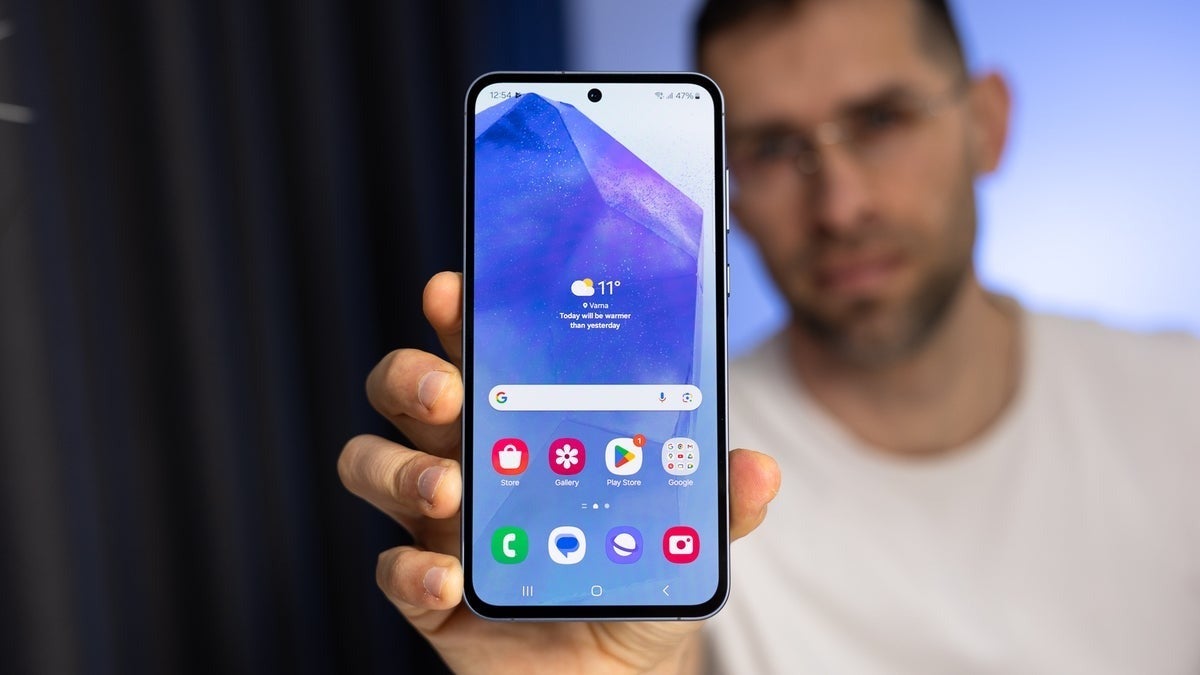MOUNTAIN VIEW, Calif.—The remarkable thing about putting on a pair of Google augmented-reality glasses for the first time in a dozen years was how unremarkable they appeared.
While the Google Glass eyewear I tried on at a fancy tech dinner in 2013 made me look like a well-dressed member of the Borg collective, I would like to think that the thick-framed prototype Android XR glasses I tested briefly at Google I/O here on Tuesday gave me more of an Elvis Costello vibe. (Especially since their built-in camera would ease watching the detectives.)
Where Glass packaged its electronics in a large pod above the wearer’s right eye, these glasses, briefly shown in a demo video at last year’s I/O, hid their gadgetry inside thick temples.
And while Google showed off Glass at 2012’s I/O with the still-unmatched stunt of having wing-suited skydivers livestream themselves parachuting onto the roof of San Francisco’s Moscone Center, Android XR’s spot near the end of Tuesday’s keynote was much more low-key.
Project manager Nishtha Bhatia streamed some backstage scenery, showed how Google’s Gemini AI could look up info for her from a photo, and briefly staged a bilingual conversation onstage with her colleague Shahram Izadi, translated live from her Hindi and his Farsi to English, that ended when the app froze.
And unlike at 2012’s I/O or even 2013’s, where Google Glass had much more of a presence, this time I got to try on the prototype hardware.
Trying Android XR on for Size
My first impression: They were lighter than I expected, although Google isn’t citing a specific weight. The display embedded in the right lens showed a calendar entry, “Glasses Demo in 6 mins,” and the current weather.
A Google rep encouraged me to look at any of the artwork hanging on the walls of this room and ask Google’s Gemini AI about them. Looking at a pointillist print, I asked “Is that painting by Georges Seurat?”; Gemini replied that it was Henri-Edmond Cross’s Two Women by the Shore.
I then asked Gemini if Cross had been inspired by Seurat, and the AI replied that this painter had indeed followed the lead of that French neo-impressionist.
The rep then invited me to take a photo by pressing the button at the front right of the frame; he said that an LED on the glasses lit up at the time.
Next, I tried out asking for directions and saw Android XR’s crafty two-way interface: When I looked down, I saw a map of my next turn projected on the floor, while looking straight ahead left me looking at simpler, turn-here-next guidance.
I asked if I could take a selfie; the answer was no because Google does not want photos published showing the hardware in too much detail. There was not, however, much to see beyond the screen, the camera, the button and a USB-C port at the bottom of the left temple. The glasses connect to a phone by both Bluetooth and Wi-Fi, depending on the amount of data being transferred.
(Credit: Google)
Get Our Best Stories!

Your Daily Dose of Our Top Tech News
By clicking Sign Me Up, you confirm you are 16+ and agree to our Terms of Use and Privacy Policy.
Thanks for signing up!
Your subscription has been confirmed. Keep an eye on your inbox!
But the rep was happy to take a bunch of photos of me wearing the glasses. Of the 16 he took, only one had the embedded display visible. And by “visible” I mean obvious, with a bright green square visible over one eye in the photo above.
Google says it’s aiming for all-day use, which could mean less than that depending on how often one were to interact with this eyewear. We won’t know for sure until the first glasses, coming from the Korean luxury-eyewear firm Gentle Monster and the direct-to-consumer vendor Warby Parker, start shipping consumer hardware on a timeframe that Google isn’t talking about yet.
Android XR Also Does Augmented Reality
Android XR also supports augmented- and virtual-reality headsets, which I tried out using an early version of Samsung’s forthcoming headset that today goes by the name Project Moohan. (Moohan is Korean for “infinity.”) This headset, like others I’ve tried, was bulky and heavy enough to make extended wearing seem an unpleasant proposition.
Simple hand gestures controlled the interface: I held my palm facing out to invoke a menu, then pinched my thumb and forefinger to select items.
I also asked Gemini about the weather back in DC; of course, it was less pleasant than the Bay Area’s dry late-spring heat. I selected a variety of YouTube videos, playing one in an immersive mode that filled my field of view, then took the presenter up on his advice to ask Gemini to take me somewhere.
Recommended by Our Editors
I chose the Yosemite Valley, which left me looking at an interactive view of the valley that I could zoom into for a close-up look at Half Dome. Samsung plans to have this headset available for sale later this year; there’s no announced price, but the extremely high-resolution displays involved suggest a four-figure number.
Presumably the AR glasses will cost less than that and the $1,500 price of Google Glass.
Thankfully, It’s Not 2014 Anymore
But at any price, Google’s new venture into smart eyewear should benefit from a vastly changed environment. A wide variety of vendors sell smart glasses, with Meta’s $329 Ray-Ban smart glasses the best-known example.
“The market really has changed,” says Avi Greengart, president and lead analyst of Techsponential. “Consumers have come to accept the concept of cameras everywhere, because everyone’s walking around with a six-inch slab of glass and a camera pointed around at all times.”
Greengart, who happened to be wearing a loaner pair of Meta’s glasses, also pointed out that the technology has changed to allow easier interaction: “With voice as an interface, you don’t have to be swiping your temple.”
The analyst did not venture a guess at a price beyond saying that smart glasses with displays occupy “a higher price bracket.” For example, a rumored Meta model along those lines would have a price tag starting at $1,000. That might make this less of a consumer item, but Google’s choice of partners suggests a focus on that market.
Greengart gave the company credit for deciding to re-enter the field by teaming up with firms already in it. “Google learned from its mistakes and from Meta’s success working with EssilorLuxottica,” he said of Ray-Ban’s parent firm. “Have it codeveloped by people who know who to make and sell things that go on your face.”

 Everything Unveiled at Google I/O 2025
Everything Unveiled at Google I/O 2025
About Rob Pegoraro
Contributor










